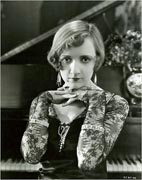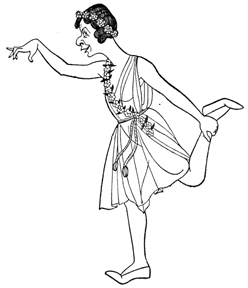SAY IT WITH SONGS
Tag: Norma Talmadge
In Your Hat, pt. 8
Here’s Chapter 8 of In Your Hat, the 1933 tell-all memoir by Hat Check Girl to the Stars, Renee Carroll, in which she shares tales of by the many celebrities she encountered while working at Sardi’s, among them George Burns and Gracie Allen, Eddie Cantor, George Jessel, Norma Talmadge, George Raft, Wallace Reid, Ginger Rogers, Douglas Fairbanks, and many more.

A STOOGE, in Broadway parlance, is the assist in the act. If you do an accordion routine and a heckler is paid by you to annoy your act from the box, then you’re probably Phil Baker and your stooge eventually becomes as famous as you are. Witness Sid Silvers of Take a Chance fame.
Broadway is full of stooges, both in real life and on the stage. It may sound strange to you but the jester in the king’s court from the time of The Erl King (I don’t know why they insist on spelling Oil as Erl) has been brought down the years until now he is labeled “stooge.” His job is to take he hard knocks, furnish the opportunity for the gag to be sprung, and appear the perfect fool.
When Phil Baker, who pumps a mean accordion, opened in a show in New York and had a stooge in the box doing the regular routine, Al Boasberg, the gagman who writes funny lines for a dozen or more comedians, wired Baker:
| LIKED YOUR ACT STOP THE OLD GENT WITH THE ACCORDION WAS GOOD TOO. |
Gracie Allen, of the famous team of Burns and Allen, is the stooge of the act, even though it is she who pulls all the funny lines. Recently she gave George Burns cause to laugh when she came to him with an idea.
“Georgie, dear,” Gracie said. “I have an idea.”
“Well, let’s forget it,” George answered characteristically, knowing it would bring on the usual headache.
“I’ve thought of a line for our act,” she continued.
“All right,” gave in George. “What is it?”
“I can’t tell you until I’ve gotten a prop.”
“What sort of a prop?”
“A muff.”
“What’s a muff?” George wanted to know.
“It’s one of those things women used to carry around so that they could hold hands with themselves.”
“All right, Gracie, get yourself a muff and let’s have the gag.”
She went to the best furrier on the Avenue and ordered a muff made. It has to be matched sables, four skins, exquisitely sewn. The muff cost $250 and she charged it to Geroge Burns, her husband. She brought it to him one day.
 “Here’s the muff, George.”
“Here’s the muff, George.”He examined it carefully. He approved.
“I got it at a bargain, George.”
George immediately became suspicious.
“How much, Gracie? How much?” he pleaded.
“Well—er—two hundred and—er—fifty dollars.”
George felt around for support.
“Two hundred and fifty smackers for that thing? Gracie, you’ll ruin me!”
“But it’s a bargain, George, and the furrier let me have it at that price because there are two holes in it!”
And she held up the muff to show him the holes in which one is supposed to insert one’s hands. Burns was nonplused.
“But what about the gag?” he wanted to know. “Is the gag worth $250?”
“Why, George,” giggled the she-stooge, “I just did it. You see, I come on with this muff and you ask me how much I paid for it and I say: ‘I got it at a bargain because it had two holes in it.”
With which Mr. Burns fainted dead away. And that’s how jokes are born in case you’re interested.
Read More »
Talmadge in the Times
A couple of worthy recent stories from The New York Times — one by Dave Kehr about the life and career of silent star Norma Talmadge:
An Independent Woman, Nobly Suffering in Silents
She was perhaps the biggest female star of the silent era. Her dark, depthless eyes gazed from the covers of influential fan magazines, projecting a nobly suppressed pain and longing; in the stories inside, she — or her ghost writers — advised the emerging independent American women of the 1920s on matters of fashion and home décor. She regularly topped the popularity polls, outdistancing rivals like Gloria Swanson, Pola Negri and Mary Pickford. She and her husband, the producer Joseph Schenck, founded their own production company in 1917; by 1924, The New York Times was identifying her as “the highest salaried screen actress.”
 Yet Norma Talmadge is barely remembered today. Worse, she is misremembered, having inspired two unfair caricatures that have lived on in a pair of popular films. In “Singin’ in the Rain” (1952), she is parodied as Lina Lamont (Jean Hagen), a silent diva whose Brooklyn accent undermines her talking debut in a French historical drama. (Talmadge’s second sound feature, the 1930 “DuBarry, Woman of Passion,” was indeed a failure, but Talmadge’s faint accent was the least of its problems.)
Yet Norma Talmadge is barely remembered today. Worse, she is misremembered, having inspired two unfair caricatures that have lived on in a pair of popular films. In “Singin’ in the Rain” (1952), she is parodied as Lina Lamont (Jean Hagen), a silent diva whose Brooklyn accent undermines her talking debut in a French historical drama. (Talmadge’s second sound feature, the 1930 “DuBarry, Woman of Passion,” was indeed a failure, but Talmadge’s faint accent was the least of its problems.)
More malignantly, Billy Wilder used Norma Talmadge as the obvious if unacknowledged source of Norma Desmond, the grotesque, predatory silent movie queen of his 1950 film “Sunset Boulevard.” Enthusiastically interpreted by Gloria Swanson, Talmadge’s rival in the 1920s, the Desmond character draws on Talmadge’s reclusiveness (she left films in 1930, living in a Beverly Hills mansion on the considerable fortune she had earned in her prime), her well-known affair with a younger man (the actor Gilbert Roland, her co-star in several ’20s hits) and her reputation for erratic behavior (suffering from severe arthritis, she became addicted to painkillers and in 1946 married her doctor) to compose the movies’ ultimate symbol of female sexual hysteria.
Norma Desmond has become ubiquitous in American popular culture, but Norma Talmadge has become all but invisible. Although an unusually high percentage of her films survive — “Of her 51 features, 32 are currently thought to be complete and 10 more are preserved in part,” Greta de Groat writes on her excellent Talmadge Web site (stanford.edu/~gdegroat/NT/home.htm) — until now only a handful of her earlier movies have been available on home video.
“The Norma Talmadge Collection” from Kino International corrects that lamentable situation by offering two Talmadge features from her glory years: the 1926 comedy “Kiki,” directed by Clarence Brown, and the 1923 melodrama “Within the Law,” directed by Frank Lloyd. Oddly, neither film is typical Talmadge. “Kiki” is a wholly anomalous comedy, with Talmadge as a Parisian street urchin who becomes a music hall star, and “Within the Law” strays from melodrama into crime-film territory. But there is enough here to get a sense of who Talmadge was and what her gifts were…. [read more]
And another, by Dan Barry, about a century and a half in the colorful life of a small hotel on the Bowery in New York City:
On the Bow’ry
Open the door to a small hotel on the Bowery.
A small hotel, catering to Asian tourists, that used to be a flophouse that used to be a restaurant. That used to be a raucous music hall owned by a Tammany lackey called Alderman Fleck, whose come-hither dancers were known for their capacious thirsts. That used to be a Yiddish theater, and an Italian theater, and a theater where the melodramatic travails of blind girls and orphans played out. That used to be a beer hall where a man killed another man for walking in public beside his wife. That used to be a liquor store, and a clothing store, and a hosiery store, whose advertisements suggested that the best way to avoid dangerous colds was “to have undergarments that are really and truly protectors.”
Climb the faintly familiar stairs, sidestepping ghosts, and pay $138 for a room, plus a $20 cash deposit to dissuade guests from pocketing the television remote. Walk down a hushed hall that appears to be free of any other lodger, and enter Room 207. The desk’s broken drawer is tucked behind the bed. Two pairs of plastic slippers face the yellow wall. A curled tube of toothpaste rests on the sink.
Was someone just here? Was it George? [read more]


